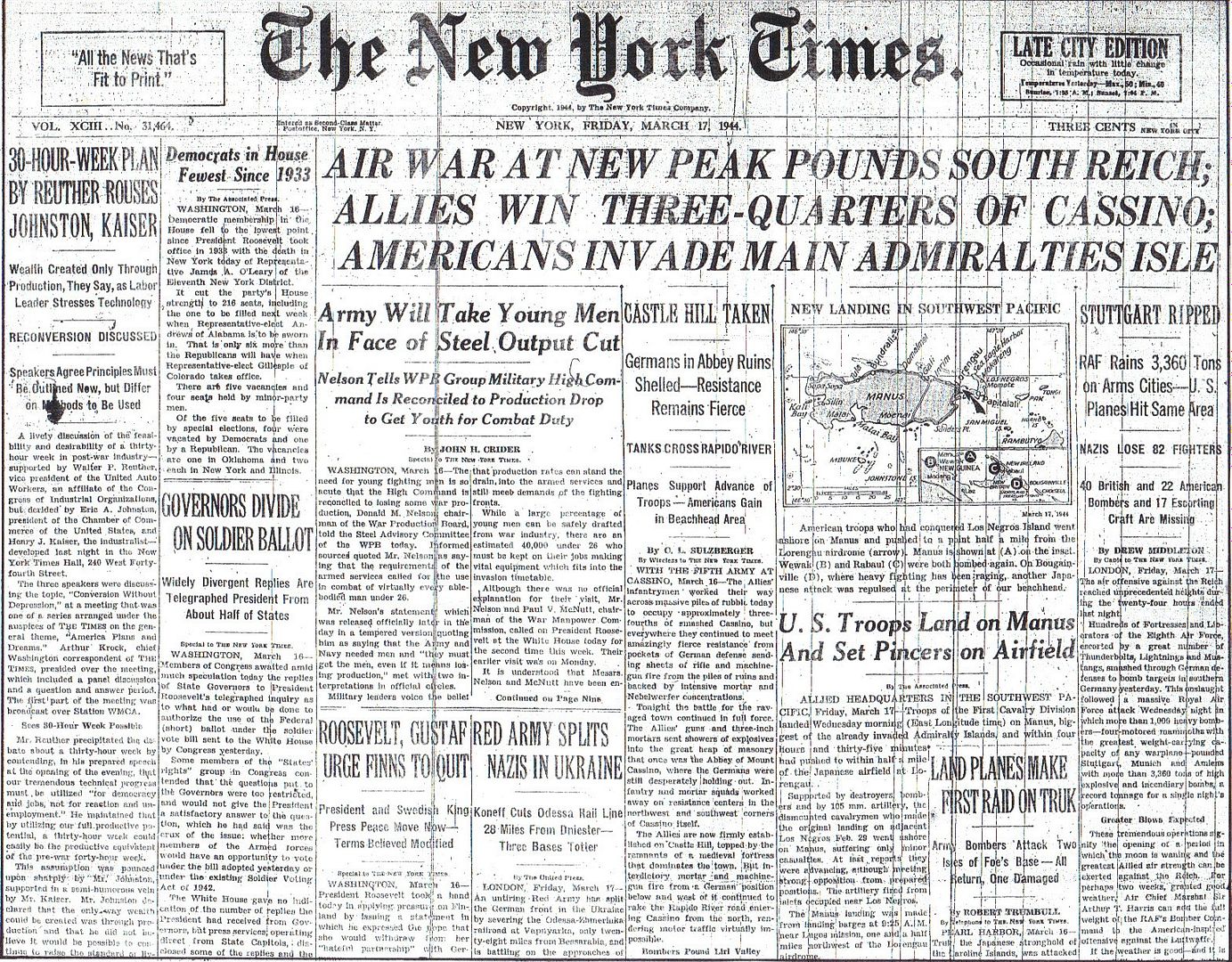
Posted on 03/17/2014 4:23:24 AM PDT by Homer_J_Simpson

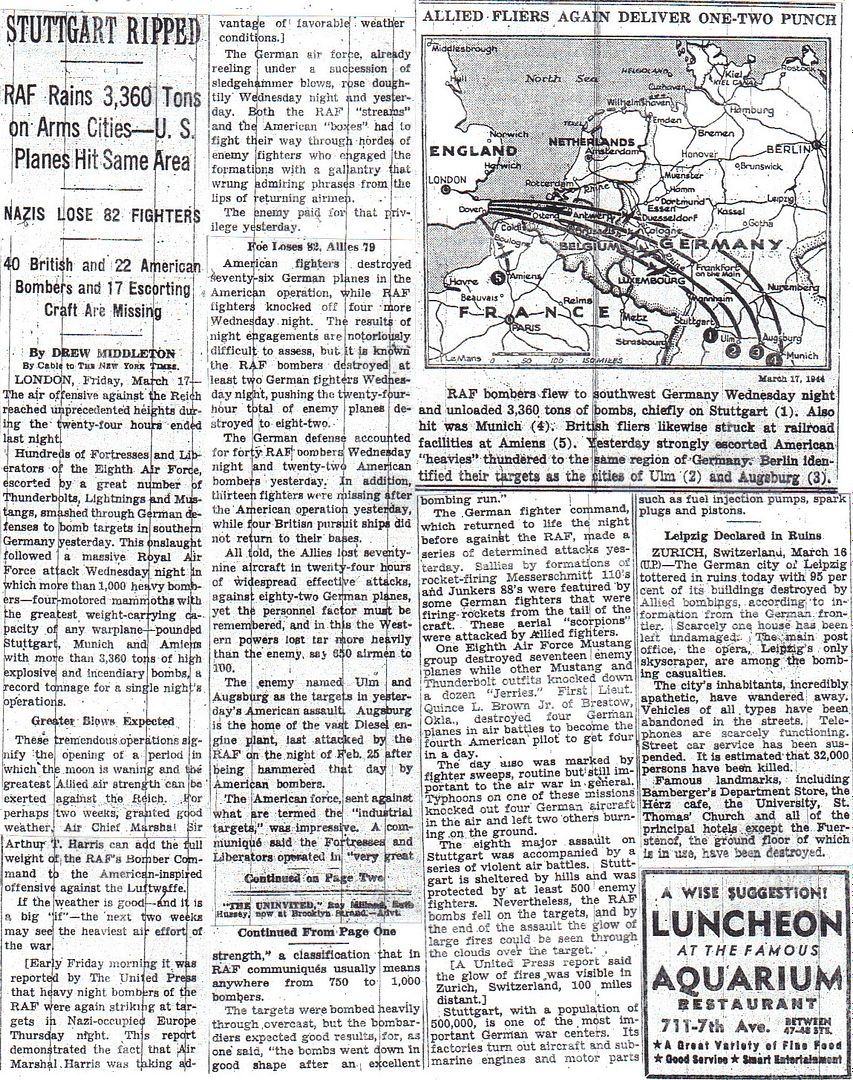
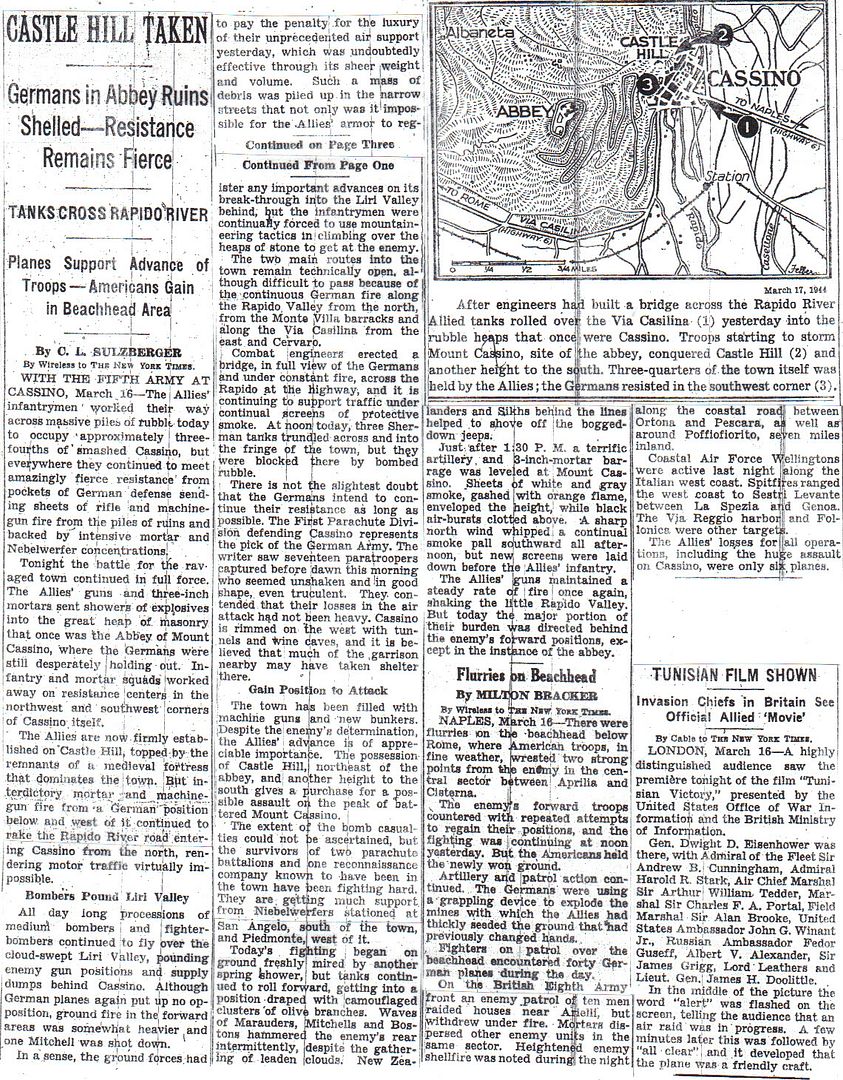
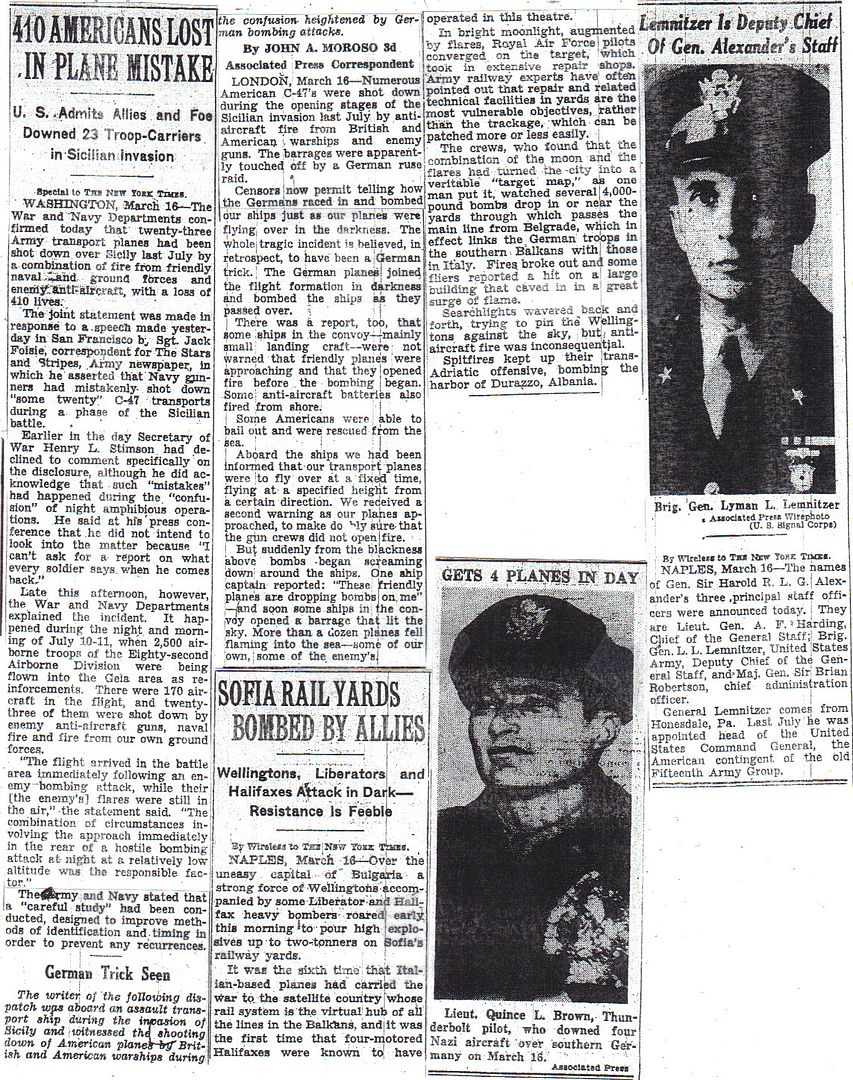
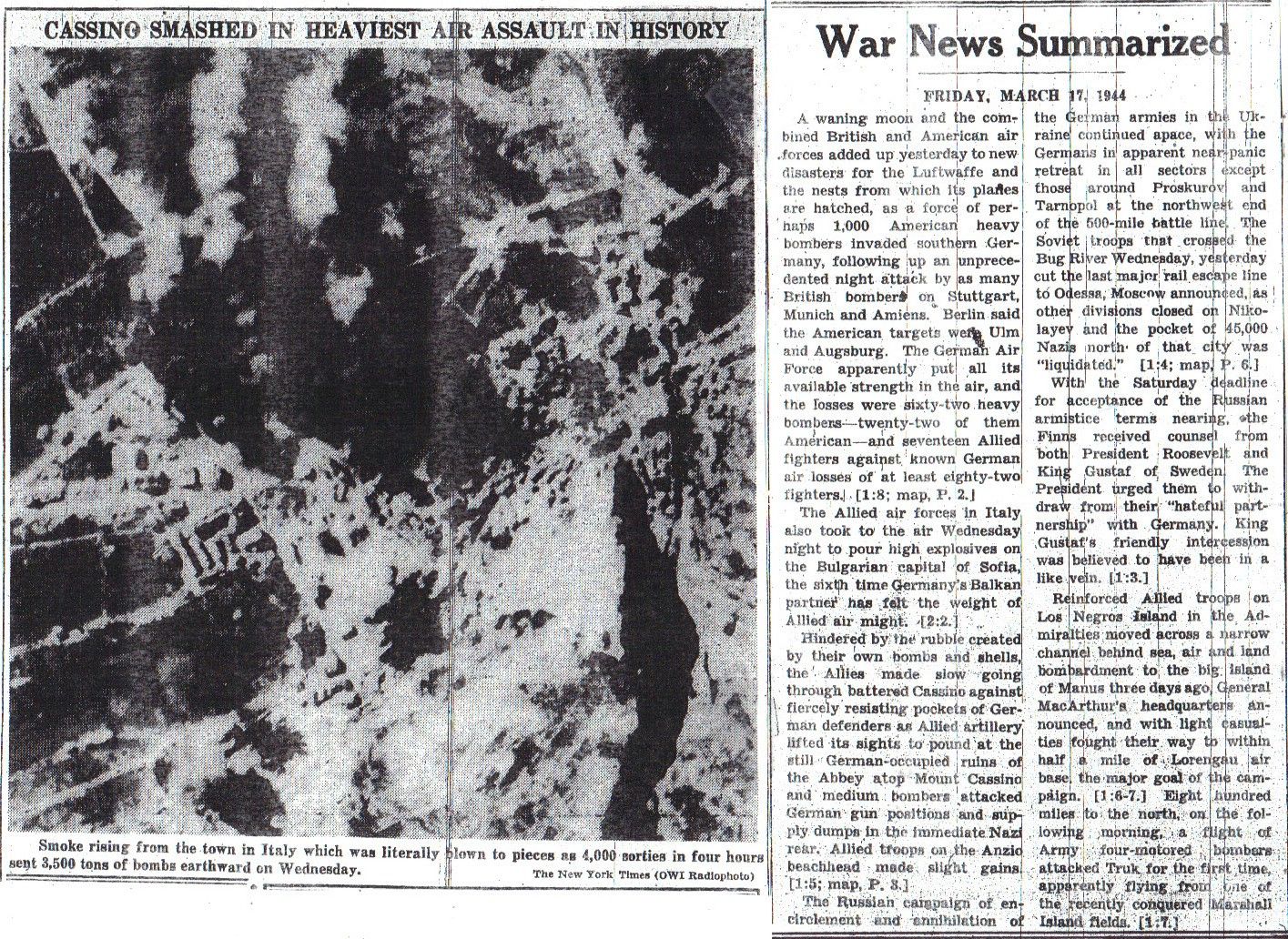
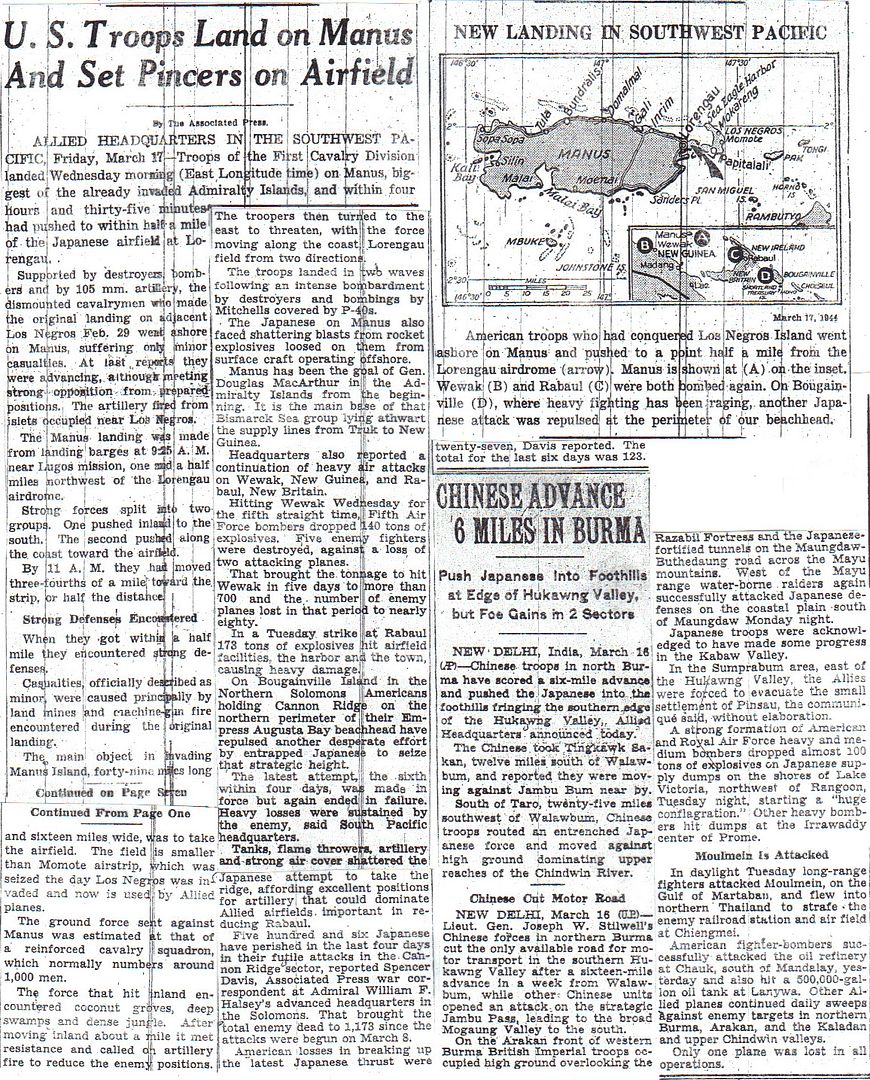
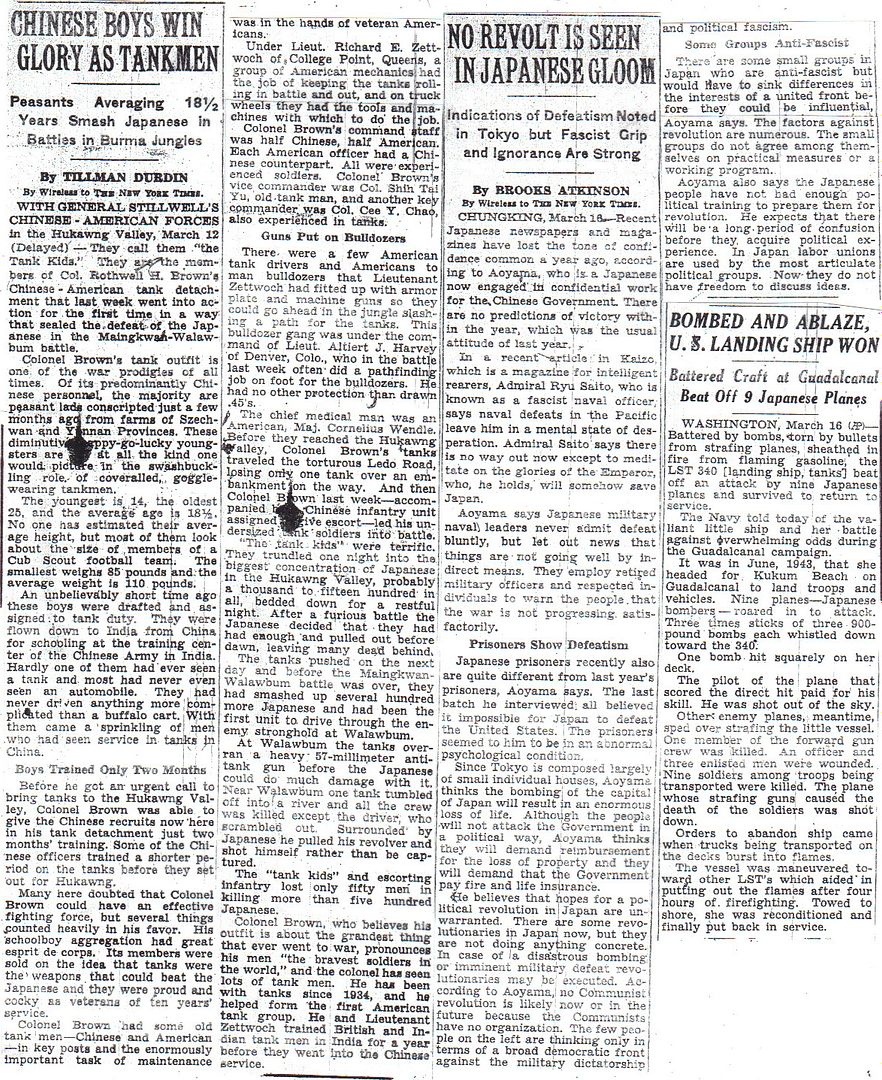
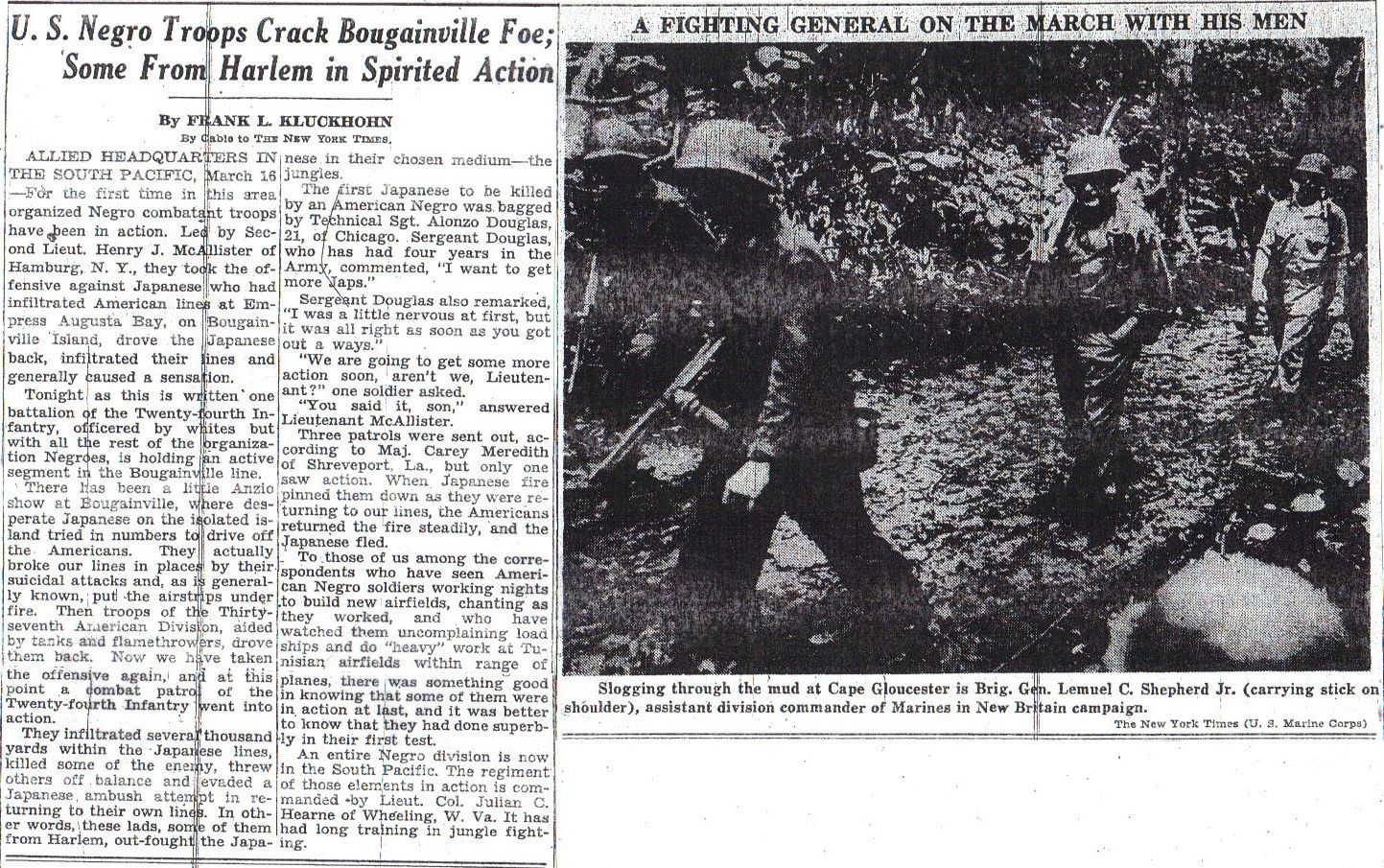
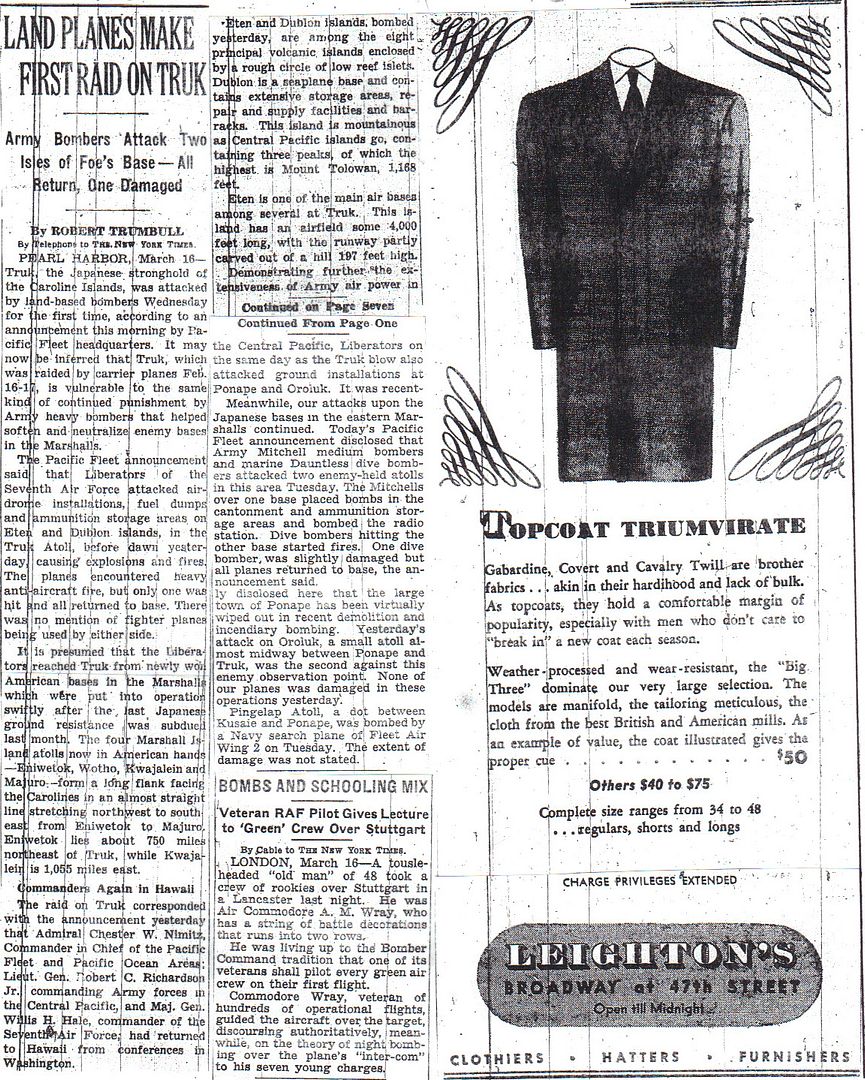
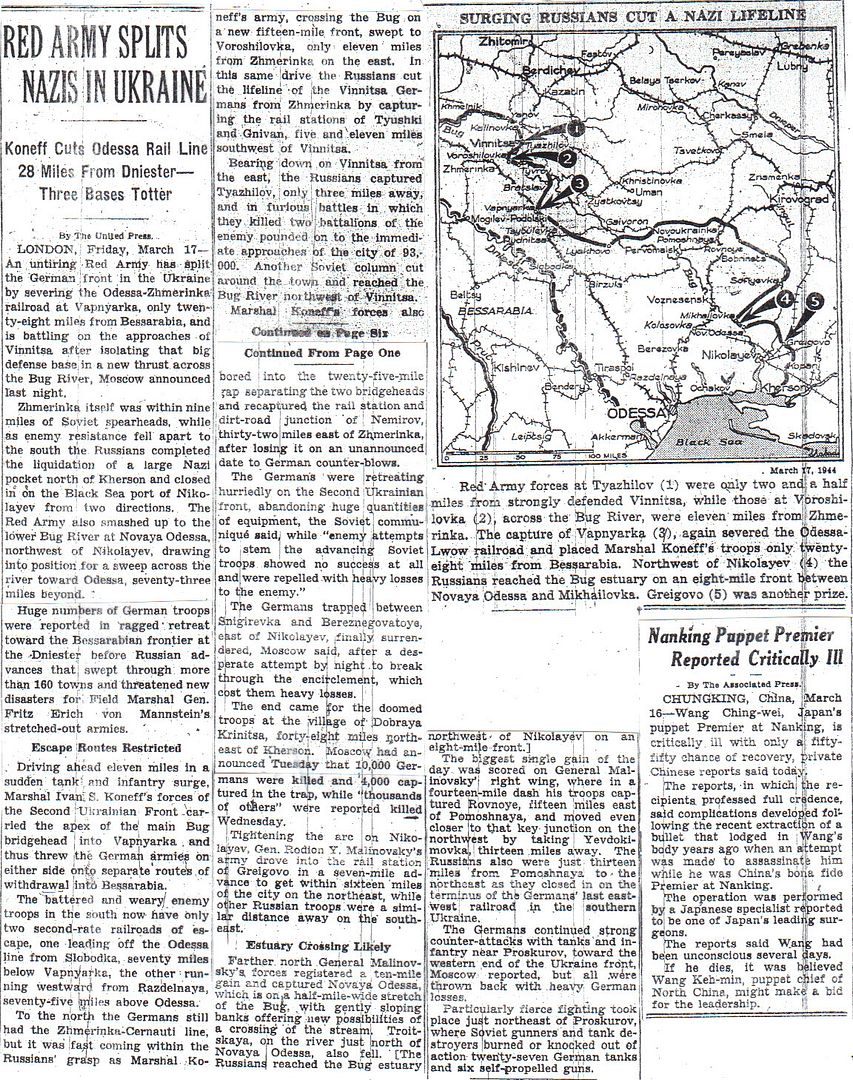

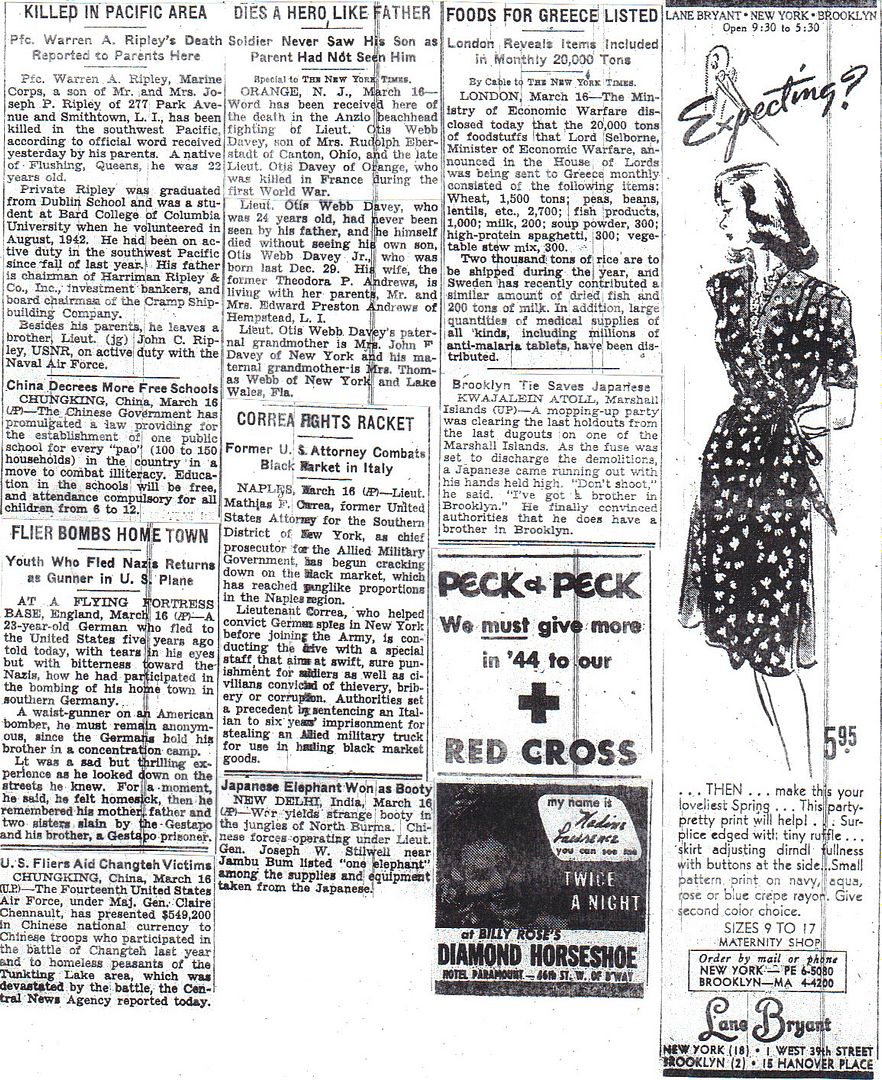
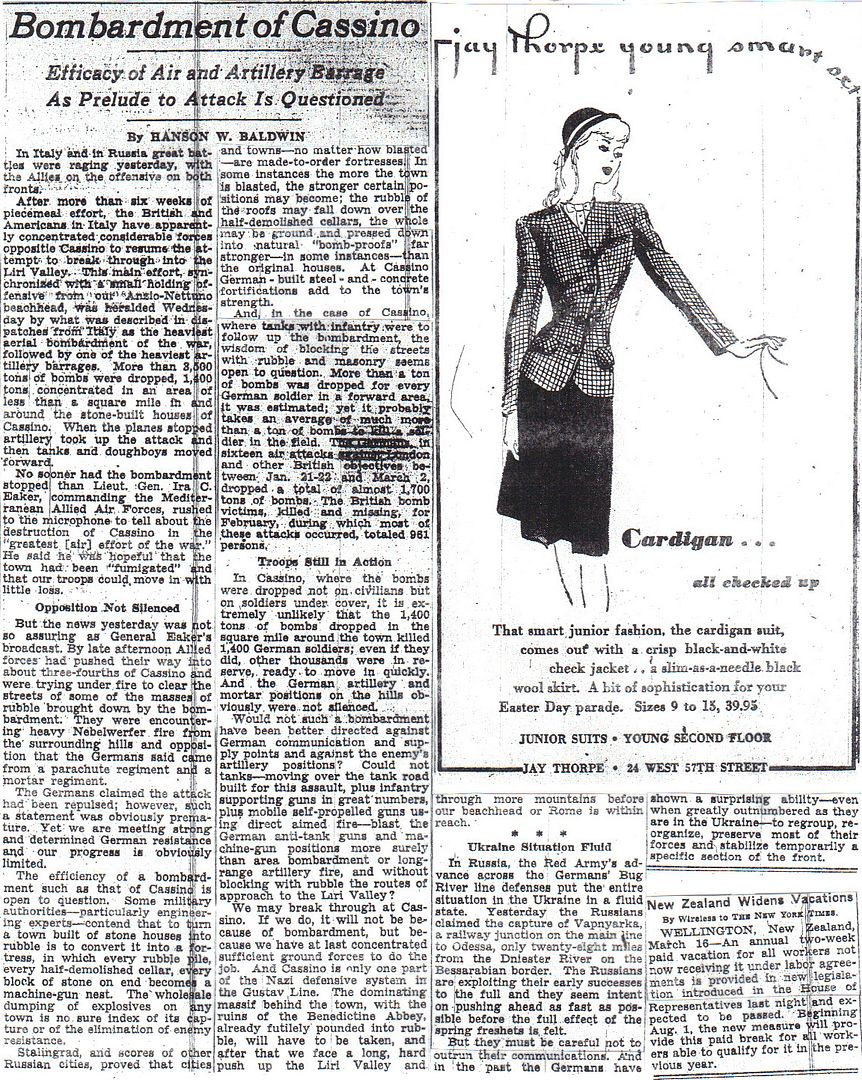
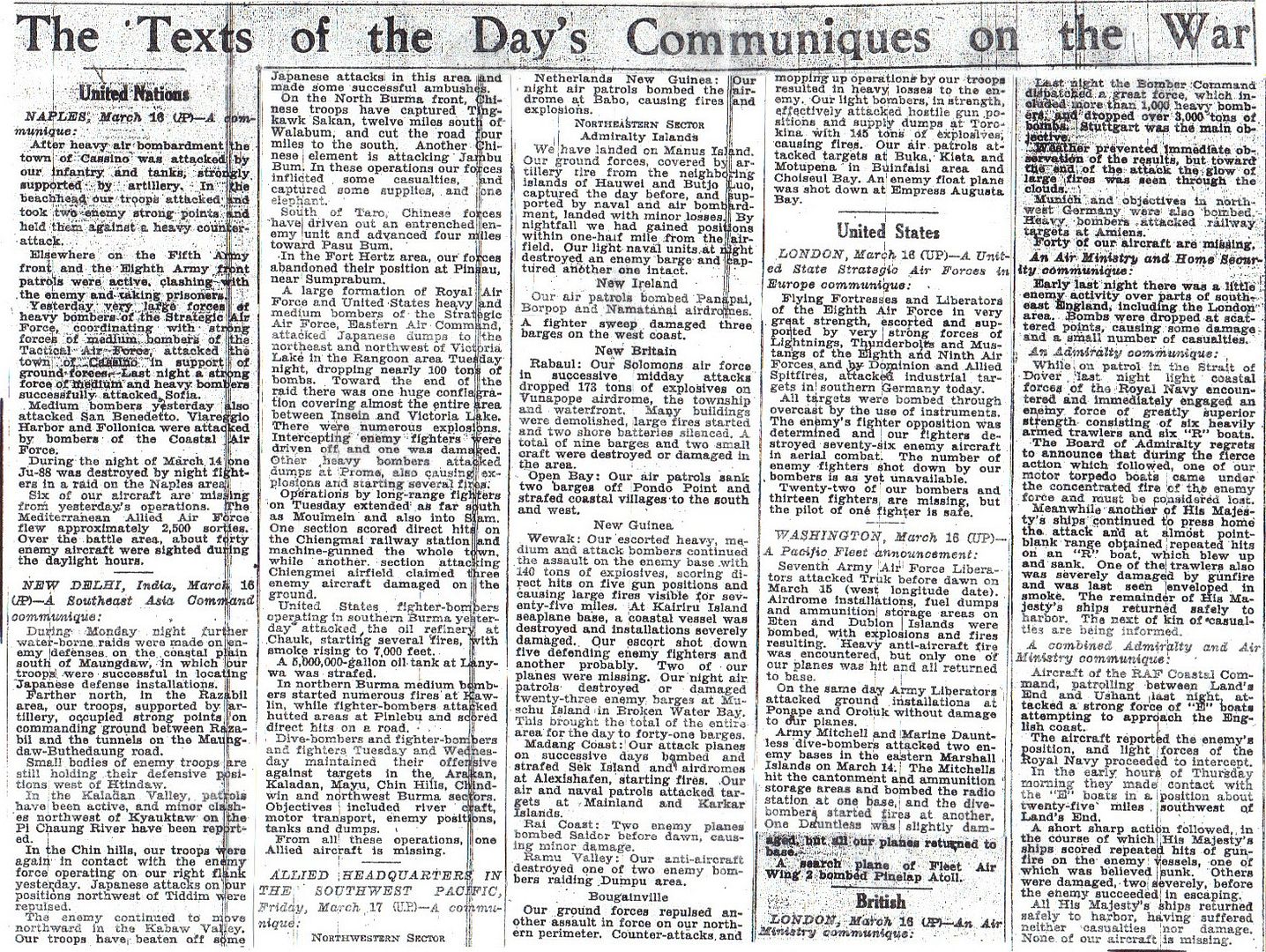

* The hard-to-read lines in the second column say, “The Germans, in 16 air attacks against London . . .”
http://www.onwar.com/chrono/1944/mar44/f17mar44.htm
Fighting continues at Cassino
Friday, March 17, 1944 www.onwar.com
German leaflet aimed at Allied troops fighting at Cassino [photo at link]
In Italy... The battle for Cassino continues. Indian and New Zealander troops of US 5th Army mount attacks on the southwest of the town and along Snake’s Head Ridge to Point 593. German forces mount attacks against Castle Hill and Hangman’s Hill.
On the Eastern Front... Forces of the Soviet 1st Ukrainian Front (Vatutin) capture Dubno in the continuing advance against German Army Group South.
In the Admiralty Islands... On Manus Island, US forces reach their primary objective and take Lorengau airfield.
In Burma... Japanese aircraft strike the “Broadway” landing zone. Several British Spitfires are destroyed on the ground.
http://www.etherit.co.uk/month/thismonth/17.htm
March 17th, 1944 (FRIDAY)
UNITED KINGDOM: Frigate HMCS Valleyfield escorting damaged HMCS Mulgrave under tow of HMS Dundee from Clyde, joined Convoy SL-151.
GERMANY: U-28 a type VIIA which was sunk on 17/March/44 at the U-Boat pier at Neustadt after an operational accident. It was raised later the same month, but struck 4/Aug/44. (Alex Gordon)
AUSTRIA: Vienna: American B-24s, escorted by P-47s and P-38s, today opened the Allied bombing assault on Austria with a raid by more than 200 planes on industrial targets in Vienna. The planes of the US 15th Army Air Force, flew from airfields in Italy. Some 100 B-17s aborted the raid because of bad weather.
Though many Austrians are serving in the German armed forces, the country has until now been largely untouched by war. The Allies appear to be in two minds about it; the Moscow declaration by Allied foreign ministers last November spoke of Austria as “the first country to fall victim to Nazi aggression”, but then warned Austrians that they have “a responsibility for participation in the war at the side of Hitlerite Germany.”
FINLAND: Helsinki: The Finns are procrastinating in their peace negotiations with the USSR despite being offered what seem to observers to be reasonable terms to end their ill-fated alliance with Germany. The Finns’ reply today is being described by the Russians as “negative”. The sticking-point now seems to be not the proposed occupation of Hango base, but the fate of German forces in northern Finland. Commanded by General Dietl, they are 100,000 strong and well-equipped. Russia wants then interned, but Finland wants to repatriate them to Germany “with full military honours.”
From the contemporary Finnish point of view the greatest problems with the Soviet terms presented in Spring 1944 were twofold:
- The Soviet demand of 600 million (uninflated 1938) USD as war reparations. The economic experts deemed it impossible to pay in the time frame demanded by the Soviets. In the peace concluded in September 1944 the sum was halved to 300 million USD and more time was given.
- The internment of Germans. I haven’t heard anything about “full military honours”, but certainly the Finns were unwilling to fight a war against the Germans. Again the time given by the Soviets to accomplish the internment was deemed to be impossibly short, and the Germans were thought still to be strong enough to attempt to occupy Finland. In September 1944 the German situation had deteriorated enough for them not to seriously entertain plans of occupying Finland, and they worked out a plan with Finns to effect the withdrawal from Finland to happen without bloodshed. Later Finns were forced by the Soviets to abandon this plan and start a serous war, but by then the civilian population had already been evacuated.
And there’s one final point to be made. The details are still uncertain, but last year there was published information from the Russian archives that seem to indicate that the Soviet terms of Spring 1944 were a trap. The purpose was (once Finns had agreed to the initial Soviet terms) that once Finns started to negotiate for the final treaty, Soviets would have presented far harsher terms. At that point Finns would had had no other options but to agree, because cease-fire would already have been made and relations with Germany severed. But Finns rejected the initial terms (which the Soviets considered lenient), and the terms finally agreed in September 1944 were milder. (By that point the Red Army had broken the Finnish front in the Karelian Isthmus by a major offensive in June 1944, but Finns had been able to defeat the Red Army in June-July 1944 once it tried to advance into southern Finland.) If it is confirmed that Stalin tried to trick Finland into submission in Spring 1944, it will for once and all terminate the old historical debate on whether it was wise for Finland to reject the Soviet terms and stay in the German bandwagon. Until the aforementioned information was published, I, for one, was of the opinion that (in hindsight) it would have been wiser to accept the terms than to lose almost 20 000 KIA in fighting the Red Army offensive to standstill and then accepting somewhat milder terms in September 1944.
BALTIC SEA Sea: U-1013 type VIIC/41 is sunk east of Rügen after colliding with U-286. There are “26 survivors and 25 crew are lost”, however, as the same figure of 26 survivors is also noted against U-286, it may be an aggregated count.
U-286 type VIIC Sank after a collision with U-1013; raised, repaired and returned to service, finally being sunk 29/April/1945.
U-28 sunk at Neustadt U-boat pier, in position 54.07N, 10.50E in an operational accident. Raised March 1944 and stricken on 4 August 1944.
U.S.S.R.: The Red Army enters the Ukrainian road and rail junction of Dubno.
Kiev: In the swift advance of the red Army in the Ukraine has brought it close to the Romanian border. Dubno, the old fortress where the legendary Cossack warrior Taras Bulba fought, fell to Zhukov today and Konev crossed the river Dniester and wheeled north to encircle the First Panzer Army.
Tonight’s communiqué says that the Red Army is fighting in the streets of the important railway junction of Mogilev-Podolski, only 40 miles from the river Pruth where it forms the Romanian border. The communiqué describing the crossing of the Dniester, said: “The advance of the Soviet troops was so swift and stunning that in a number of places the Germans had no time to destroy the ferries and bridges. They suffered enormous losses.” With the Lvov to Odessa railway line cut, the key supply route to the southern sector of von Manstein’s Army group has been broken, and as the Russians advance they threaten to split the German forces in Poland from those in southern Russia.
MEDITERRANEAN SEA: At 0938, U-371 fired a Gnat at Convoy SNF-17 about 30 miles MME of Bougie and observed a hit on a ship, which settled by the stern after the hit. At 0942, a spread of three torpedoes was fired and two hits were heard. After another Gnat at 0948, a further detonation on another ship was heard. The first torpedo struck Maiden Creek in station #52 and the second US troop transport Dempo. The first ship was sunk at 1350 by a coup de grâce. A torpedo hit Dempo on the starboard side. Against orders, the crew immediately began to abandon ship, while the master tried to beach his ship, but she settled slowly and sank around 1055. Maiden Creek was hit by a torpedo forward of the #4 hatch. The explosion broke the shaft, the back of the ship and filled the #4 hold and the engine room with water. The eight officers, 40 crewmen, 29 armed guards (the ship was armed with two 3in and eight 20mm guns) and one passenger abandoned ship in two lifeboats and a raft as the ship slowly settled by the stern. The boats waited two hours near the vessel until an escort appeared and ordered the men back on the vessel to prepare her to be towed by a tug. They tied up the boats at the stern and reboarded the ship. At 1350, the U-boat fired a coup de grâce, which struck on the port side in the stern. The explosion lifted the ship out of the water, destroyed the lifeboats and killed one officer, two armed guards and five crewmen. The survivors jumped overboard and swam to a single raft near the ship. They were rescued after 30 minutes by motor launches from a British destroyer and brought to Bougie. The badly damaged Maiden Creek was towed by a British escort vessel to Bougie on the morning of 18 March and beached, but broke in two forward of the #4 hold and was declared a total loss. 498 servicemen died.
BURMA: Air Commando Combat Mission N0. 31 2:35 Flight time. Hailakandi, Assam to Malu, Burma. Bombed Japanese positions at the Malu Road block. (Chuck Baisden)
CANADA: Corvette HMCS Calgary completed refit Liverpool , Nova Scotia.
U.S.A.:
Minesweeper USS Augury commissioned.
Destroyer USS Gendreau commissioned.
ATLANTIC OCEAN: U-801 (type IXC/40) is sunk near the Cape Verde Islands, in position 16.42N, 30.28W, by a Fido homing torpedo from 2 Avenger aircraft (VC-9) of the US escort carrier USS Block Island and depth charges and gunfire from the US destroyer USS Corry and the destroyer escort Bronstein. 10 dead and 47 survivors. The boat was attacked by an Avenger aircraft from the escort carrier USS Block Island in the Mid Atlantic on 16 Mar, 1944. One man died and 9 men were wounded. The U-boat was sunk the next day. (Alex Gordon)
The Soviet dance with Finland to woo them away from the Germans was quite interesting. It appears the sticking point is that the Soviets want the Finns to actively turn on their former comrades in arms, while the Finns wish to simply quit fighting.
The Soviets pursued a similar policy in regard to Romania. When the Romanians “defected” in August 1944, part of the deal was that the Romanians would actively turn on their former Axis partners. The Romanians did so, despite the Red Army making the usual pigs of themselves in Romania. Unfortunately for the Axis, they had given the Romanians plenty of cause to turn on them. At the time of Romania’s defection, the Germans first reaction was to bomb Bucharest. It was a waste of air assets badly needed to aid the German army fighting the Soviet tide, and I’m not sure how you keep an ally at your side by bombing their capital. All it did was piss off the Romanians.
The other incentive was that the Romanians shared a mutual hatred of their nominal Axis partners, the Hungarians. In 1940, in the infamous “Vienna Award,” Ribbentrop had taken Transylvania from Romania and given it to Hungary. Naturally, the Romanians wanted it back and were only too happy to take it by force. So the Romanian 3rd and 4th Armies, which deserted the Germans on the battlefield in August, re-appeared on the Eastern Front in the Soviet order of battle. Of course, there were considerable changes in the officer corps.
After the war, Transylvania was returned to Romania as their reward for being turncoats, although they did lose Moldavia back to the USSR. Transylvania was then “ethnically cleansed” of the Hungarian population, which had been the cause of all of this conflict. They had been about 40-45% of the population of that region.
All part of the huge forced ethnic migrations performed between 1944 and 1950. The Finns were lucky they didn’t have to be pimped like the Romanians.
Thanks for posting this illuminating background on the Romanian/Hungarian situation and with the other details!
The Romanians switched sides just in time to stave off a Russian invasion. It's a little surprising they did that in light of the loyalty they had shown the Axis across Ukraine, but on the other hand they had seen first hand what a Russian invasion looked like. And you make an excellent point that the Romanians had something to fight for to take Transylvania back.
Disclaimer: Opinions posted on Free Republic are those of the individual posters and do not necessarily represent the opinion of Free Republic or its management. All materials posted herein are protected by copyright law and the exemption for fair use of copyrighted works.